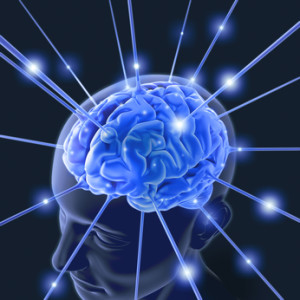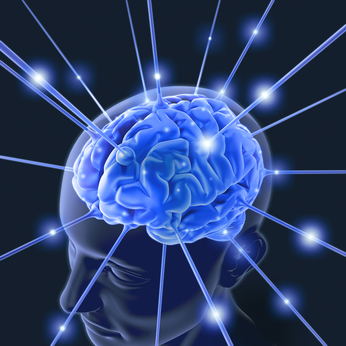
Michael J. Fox is probably the most well known person with Parkinson’s disease. Viewing the progression of his Parkinson’s between 1991 and an interview he did on Oprah in 2010 gives you an indication of how debilitating it can become. There is a treatment called Deep Brain Stimulation (DBS) that effectively silences the tremors. The dramatic therapeutic difference can be seen in this YouTube video of a New Zealand man named Andrew Johnson who has Early Onset Parkinson’s. The difference is dramatic and it is easy to see why he would agree to the procedure. What’s not to like about it and why would Michael and others put off trying it? It involves surgery that implants electrodes into your brain.
As described by the NIMH, DBS surgery begins with shaving your head and attaching it with screws to a sturdy frame that prevents the head from moving during surgery. The patient is awake during the procedure to help the surgeon with feedback. Patients feel no pain, however, because their head is numbed with a local anesthetic. MRIs are taken of the brain to guide the surgeon during the operation.
Once the above prep work is completed, two holes are drilled into the head. The surgeon then threads a slender tube down into the brain in order to place electrodes on each side of a specific part of the brain. After the electrodes are implanted and the patient provides feedback about the placement, the patient is then put under general anesthesia. The electrodes are now attached to wires that run inside the person’s body down to the chest, where a pair of battery-operated generators are implanted.
Electrical impulses are then continuously delivered over the wires to the electrodes in the brain. After the device is fine tuned, it reduces tremor and uncontrollable movements, stiffness and walking problems related to Parkinson’s. You can see how this all works afterwards in the Andrew Johnson video. At this point, DBS has been used in more than 100,000 people worldwide.
Helen Shen wrote in Nature that the biological mechanism underlying DBS is still unknown. Michael Okun, a neuroscientist, said there has been a lot of guesswork done with DBS over the past twenty years. “It would be premature for anyone to claim they know how the therapy works.” There are some hypotheses, though. The current theory is that DBS somehow disrupts or represses pathological signals that reverberate through multiple brain regions, thus corrupting their communications.
This fits with the emerging view that Parkinson’s disease, depression and other neuropsychiatric conditions are best understood as neural network dysfunctions. At this time DBS is approved by the FDA to treat the following: essential tremor (1997), Parkinson’s (2002), dystonia [a neurological movement disorder] (2003) and OCD (2009). There is research being done to assess it applicability to addiction and depression.
Helen Shen described a new device from Medtronic that is now being used in DBS treatment. The Medtronic neurostimulator not only will send electricity into the brain, it will also read neural signals generated by the brain and send them out.
Until now, such data have been accessible only when a patient’s brain is exposed briefly during surgery. But being able to make long-term neural recordings from human patients may become increasingly important — especially because researchers are experimenting with using DBS as a treatment for many other neurological conditions.
But the neural networks in these other neurological disorders are even less understood than those involved in Parkinson’s. Helen Mayberg, a neurologist at Emory University said devices like the Medtronic neurostimulator could change that, but “Every disease will be different and one size won’t fit all. . . . [However] the new technology is going to enable progress exponentially.” Helen Bronte-Stewart, a neuroscientist, said this was an exciting time. “This is the first time we’re really getting a window into the brain.”
Others, such as medical ethicist Joseph Fins, urged caution. He also indicated that while the sensiorimotor network involved in Parkinson’s disease is mapped out in great detail, the other disorders have much less guidance available. “There has got to be a biological rationale for what you’re intending to do.” Others argue that controlled testing of DBS in humans doesn’t need to wait for complete or near complete understanding of the relevant networks. Benjamin Greenberg, a psychiatrist at Brown University said that as a clinician, that wasn’t an important question. “The real questions are: do these treatments help people? Are they safe?”
The NIMH indicated, “DBS carries risks associated with any type of brain surgery.” The side effects or complications could include: stroke or bleeding in the brain; infection; disorientation or confusion; unwanted mood changes; movement disorders (isn’t DBS supposed to treat these?); lightheadedness; trouble sleeping. And DBS does not halt the progressive neurodegeneration of Parkinson’s. In the long run, patients will succumb to symptoms not effectively treated by DBS, like cognitive deterioration.
An article by Jeanene Swanson for The Fix referred to DBS surgery as a “relatively simple neurological procedure” (?) that could be used to treat a variety of disorders, including addiction, severe depression cluster headaches and obesity (None of these are approved DBS treatments at this time). DBS treatment for addiction was accidently “discovered” in 2006 by Jens Kuhn of the University of Cologne when Kuhn tried DBS as a treatment for panic disorder. “Recent valid animal studies show significant induced improvement in cocaine, morphine, and alcohol addiction behavior following DBS of the nucleus accumbens.”
Wayne Hall indicated that the interest in using DBS for treating addiction isn’t great. He suspected this was because it is an expensive, high technology intervention for a small minority of patients. He further noted that interest has declined for using DBS for depression because of poor trial results. However, that could be resurrected if more promising sites for stimulation were identified.
I would predict that if DBS is used for addiction in the future it will only be used in a minority of patients and will remain a niche treatment for addiction rather than becoming a mainstay form of treatment as it looks like it’s becoming for Parkinson’s disease and other movement disorders.
Dr. Nadar Pouratian of UCLA thinks it can be a promising treatment for addiction, but the earliest it could be available would be five years from now. “I think it’s a promising therapy for a spectrum of diseases, including addiction, but we need to be a little bit more methodical or careful—every time a trial does not work, the negative repercussions [do] far greater harm to the field.”
Could that be because DBS for addiction and depression is therapeutic overkill? Could it be because it’s dangerous when applied for addiction and depression? When the current state of knowledge doesn’t know how DBS works, and when the complexity of the neural networks for addiction and depression aren’t clearly understood, treating them with DBS seems like taking a huge risk.





